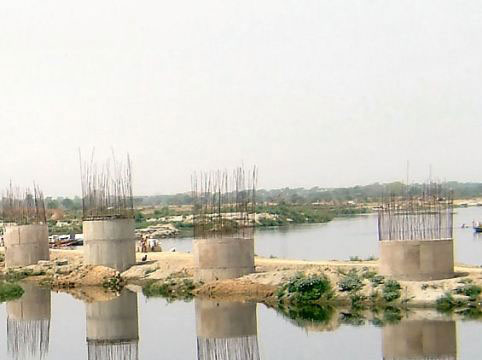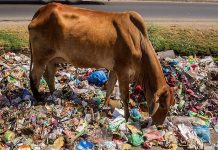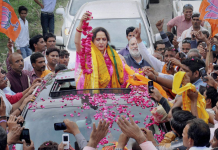A Full Range of Considerations Regarding the Possibility of a 25 Concrete Pillar Flyover in Front of the Historic and Protected Landmark Jugal Kishore Mandir at Keshi Ghat, Vrindavan.
The Negatives:
- The Flyover would drive the Yamuna further away from Vrindavan.
- The Flyover would surround pilgrims searching peace and water purification (achman) for their parikrama vratas with constant noise and smog pollution.
- The Flyover would destroy the historic view of Keshi Ghat from the Yamuna, which has been photographed millions of times and used to depict Vrindavan in print, video and online media.
- It is unique and very beautiful. If the entire ghat area would be restored and a Yamuna channel be brought back to flow either in front of the ghats or in front of the present parikrama road, the true original beauty of Vrindavan would be brought back to life, enhancing pride and devotion in the town.
- The Flyover would cause further siltation of Vrindavan’s wells due to Flyover’s interference with natural drainage of water and water table recharge.
- The Flyover would cause increased Yamuna pollution since it traps black raw sewage in front of the ghats, which eventually finds its way into Vrindavan’s ground water and creating a health hazard.
- The Flyover would destroy an already highly endangered area of diversified river life including turtles and river dolphins.
- The Flyover and resulting increases in traffic would make parikrama life-threateningly dangerous, running pilgrims off of the Parikrama Marg or even the flyover itself causing them either to fall into the water or onto the Yamuna’s littered banks when water recedes during the lean season.
- The Flyover will cause traffic to connect to the Mat Aligarh Bridge from Raman Reti. This will turn a supposed parikrama path into a major traffic road, destroying peaceful parikrama and causing major accidents due to speeding (This is already happening on Parikrama Marg, which is currently in the middle of a years’ long construction project based on ill-conceived plans).
- The Flyover will cause new areas of illegal garbage dumping.
- The Flyover will cause encroachment in the riverbank area by temporary shanty town business structures like we see all over the parikrama today, further interfering with proper floodplain drainage and subjecting encroachers to the dangers of monsoon flooding like that which occurred earlier this year.
- The Flyover would be an historic example of environmental disaster, putting shame on its planners as it is publicized throughout the world. There are already scholarly and public opinion articles and even books published both in India and internationally that question how Krishna’s sacred sporting place and divine consort Yamuna-ji could possibly be purposely strewn with garbage, sewage and arbitrary constructions with rubble lying everywhere.
- The Flyover would represent a disaster for a city of India whose religion and history constitute a heritage of unique value for the whole world. Vrindavan has not yet achieved official World Heritage Status, largely due to developers and politicians too short sighted to make sensible plans for expansion and infrastructure, but the town’s world heritage value has been acknowledged by people from UNESCO and other national and international heritage organizations on several occasions.
- The Flyover would represent a disaster for a place unique for its status as a sacred place of pilgrimage, visited by over 80 million pilgrims each year.
- Traditional ceremonies such as the daily visited Yamuna Artiks and Sraddha Ceremonies for the departed would be held in front of sewage water and a concrete Flyover with noisy tractors and trucks going into both directions.
- Finally, the Flyover is not necessary for successful “development”: It is possible for Vrindavan to continue welcoming new pilgrims by making a bridge – one that spans the river, connecting both sides, as opposed to the semi-circular flyover that does not facilitate the practical and beneficial use of the land opposite the Yamuna from Vrindavan. This bridge could be built before the Madan Mohan temple along the lines of the proposed master plan for Vrindavan conceived by Sevak Charan ji and presented in conjunction with other leading local citizens 28 years ago in Tatiasthan ashram.
This bridge could be attached to a road on the other side of the Yamuna connecting to the road to Mat Highway and the existing bridge. This connecting road could be constructed behind a green belt of trees, avoiding traffic for Vrindavan and maintaining beauty and serenity. A parking space adjacent to this road on the other side of the Yamuna would allow pilgrims to visit Vrindavan via boat or via the pontoon bridge built every year.
The Positives, with counter considerations:
- The Flyover speeds up procession around the Keshi ghat area facilitating the movement of large parikrama groups and cars.
Answer: This s a definite advantage and sounds a little attractive especially since the old ghats before Keshi ghat are crumbling and creating life endangering situations.
Counter consideration: The same advantage can be achieved through less damaging means: Why not think about Haridwar and Rishikesh, where traffic does not disturb pilgrims or natural beauty. Is Vrindavan less sacred or less important than these holy towns?
A few new steps would solve all Vrindavan’s problems: a space can even be created for rickshaws to carry old people. Movement, Peace, Safety and Meditation could be facilitated for all. All heavy traffic passing from one side of Vrindavan to the other would naturally go through newer parts of town like Chaitanya Vihar or Pagal Baba Mandir, connecting to the main bridge proposed above and reaching all over town through Mathura Road.
Vrindavan is situated like a peninsula with water on three sides. This makes a ring road unrealistic, unappealing, unsafe and, for pilgrims, undesirable. If the ring road idea was to be applied to a practical and beautiful engineering project, it would be on the other side of the Yamuna.
The need of green belt and forest area cannot be ignored. It is necessary to mitigate abuses already inflicted by MVDA housing projects that have turned much of the open land around town into haphazard urban sprawl while adequately planned basic infrastructure and proper treatment and disposal of the black waters was ignored. Nalis constructed in 2010 still direct black water from all over town into the Yamuna, as do previously constructed nalis. (This violates judgments of both the Supreme Court and Allahabad High Court). - The Flyover will allow people to take pictures of Keshi ghat.
Counter consideration: Pictures facilitated by the flyover will only serve as a historic record of the Keshighat area: without Yamuna water. A view of garbage thrown from the flyover in front of the ghats will take the place of the previous flyover-free panorama that people now photograph from boats. - The Flyover will increase the Business of Vrindavan.
Counter consideration: Happy pilgrims are the backbone of the business of Vrindavan. It should be recalled that Before Bhaktivedanta Swami made it famous all over the world Vrindavan was a very silent town even on main holidays. The fame that Bhaktivedanta Swami accorded Vrindavan greatly increased the numbers of pilgrims (not tourists) and increased prosperity for Vrindavan business. People who quickly take in the town’s main sites and move on are not going to bring business to Vrindavan, but to the roadside bazaars and shops along the nearly completed Yamuna Expressway. - The Flyover is modern and the first big engineering project done to make Vrindavan look like a modern city.
Counter consideration: Old Vrindavan near Keshi ghat is not a modern city; it is a medieval pilgrimage town. A “modern” Vrindavan can develop away from the areas that hold the great religious, historic and cultural treasures. Heritage cities all over the world try to avoid developments like the flyover at all costs, because they know that aesthetics, cleanliness, safety and the integrity of cultural practices and heritage structures are all endangered by such developments.
Concluding Remarks:
The Flyover was the result of arbitrary planning unsupported by preliminary studies on viability, alternatives or environmental impact. No model was ever made. No plan was made by independent architects.
Pillars that were already constructed for the flyover tilted or collapsed in the first flood of 2010, indicating that planning and workmanship are poor and, like many structures, will not withstand several monsoon seasons and their accompanying floods.
The Flyover offends aesthetic feelings of Vrindavan’s heritage art, which is valued by devotees, academics, conservationists of built heritage and historians everywhere.
The Flyover helped awaken a public consciousness that civil action must be taken to protect Vrindavan. The Braj Vrindavan Heritage Alliance (BVHA), a public forum open to all, was formed to make everyone aware of the facts surrounding the flyover so they may reach an informed opinion and hopefully persuading citizens in favor of the bridge to change their stance to protect Vrindavan. BVHA (online bvhalliance.org) is also determined to rally concerned citizens together as one to resolve many other problems Vrindavan is facing.
Please write or call vrindavantoday.com editor Jagadananda or call Devendra Chaitanya Maharaj at 91 9410084200 to be invited to BVHA meetings, to participate in BVHA action committees, or to submit a commentary for publication sharing your views on problems and prospects regarding Vrindavan’s future. With a straw between my teeth I beg you all: Let us serve Vrindavan together.
Eliminate sewage flows into the Yamuna and garbage littering throughout town.
All with the help and mercy of Srimati Radharani.











